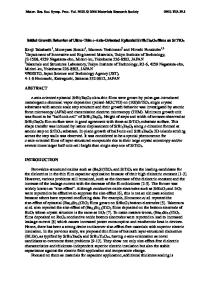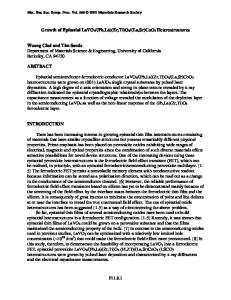Epitaxial Growth of BaZn 1/3 Ta 2/3 O 3 Thin-Films for Microwave Applications
- PDF / 1,013,987 Bytes
- 5 Pages / 417.6 x 639 pts Page_size
- 0 Downloads / 398 Views
confinement of electric field (i.e. low variation loss) and (3) near-zero temperature coefficient, Tf, for thermal stability and reduced phase noise. BaZn1 /3Ta2 /30 3 (BZT) and related compounds have emerged as one of the most likely materials to satisfy the needs of the future commercial dielectric market. BZT has a large dielectric constant (Fr-30) and ultra-low loss tangent (tan 6 < 2x 10-5 at 2 GHz)[2-4]. When doped with Ni, the temperature coefficient, rf, can be tuned to near-zero[2]. Zr is also commonly used in conjunction with Ni to significantly reduce the annealing time required to obtain the high-Q state[5]. There is strong experimental evidence that extended defects [6] and /or point defects[7] play an important role in limiting the loss tangent in practical microwave material. In this paper, we report the first epitaxial growth of BZT thin films. MgO is chosen as a substrate due to its excellent lattice match to the BZT pseudocubic lattice (-2.7%) and low cost. The long-term goals of this work are aimed at: (1) improving the structural quality to determine the ultimate microwave performance of the material, (2) synthesizing
materials such that the intrinsic optical, magnetic and electronic properties of the material can be measured without the complexities associated with polycrystalline ceramics and (3) developing methods to synthesize BZT that is compatible with current thin-film
163 Mat. Res. Soc. Symp. Proc. Vol. 574 © 1999 Materials Research Society
technologies (including high-Tc superconductor (e.g.YBCO/MgO) and semiconductor Field Effect Transistor structures). EXPERIMENT Thin films were grown on 0.5 cm x 1.0 cm MgO (100) substrates using pulsed laser deposition. The excimer laser was operated at 248nm wavelength, 5Hz repetition rate, -330 mJ energy per pulse and -2.5J/cm 2 flux at the target surface. Growth was performed at an oxygen pressure of 230 mT and substrate temperatures from 500 to 600'C. Bulk BZT ceramic materials produced by Trans-Tech Inc. (8700 series) were used as targets. Measurements were performed on films grown using 8733 material (Ba 3Ni.125OZr.o09Zn.8 45Tal.940 3) with the exception of optical transmission spectra which were performed on films grown using 8735 material (Ba 3Ni.0375Zr.05oZn.9 12Tal.9003). X-ray coupled scans and (D scans were made on a double crystal diffractometer with CuIQ1 radiation (0 = 1.5406 A). The in-plane registry was examined by 4)scan of the asymmetric (202) reflections with a high-resolution four-circle diffractometer. The surface morphology of the films was characterized by Atomic Force Microscopy (AFM) using a Digital Instrument' Nanoscope III Scanning Probe Microscope (SPM). Optical transmission measurements were performed in the visible spectral range at room temperature using a Varian Cary UV-Vis spectrometer. Film thickness was measured using cross-section Scanning Electron Microscopy (Hitachi S-4500). The refractive index, n, was determined from Fabry-Perot fringes. The product of refractive index, n, and film thickness, t, was inferr
Data Loading...










